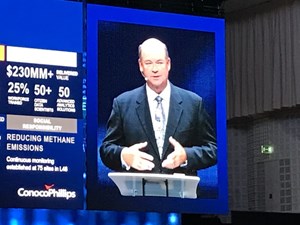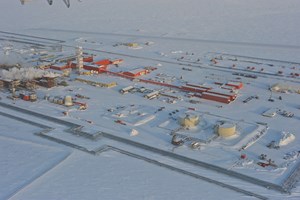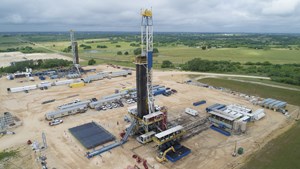SLB Digital Forum: COP’s Lance says his firm has multiple goals in a digital world
(WO) — ConocoPhillips Chairman and CEO Ryan Lance says his challenge in running a premier upstream operator is to keep producing oil and gas efficiently, generate good dividends to shareholders, harness the digital transformation’s benefits and achieve ESG goals—all simultaneously. Lance updated the status of his company operations and its efforts to connect things digitally during Schlumberger’s Digital Forum 2022 in Luzern, Switzerland, last week.

Lance pointed out that oil and gas continues to be one of the highest-tech industries in business today (even if the public doesn’t always realize it). “The capabilities we enjoy today were a dream just a few decades ago, which you (Forum attendees) helped make a reality,” he observed.
Some corporate stats. In taking a broad look at his company, Lance called ConocoPhillips (COP) the world’s largest independent E&P company. The firm is active in 13 countries and six regions around the world, including Alaska, the U.S. Lower 48, Canada, Europe, Middle East, North Africa, Asia-Pacific and other International. “We’re particularly strong in North American shale,” acknowledged the chairman. But then he threw in a surprise statistic. “We’re growing in the LNG business. In fact, and some of you don’t know this, we have the industry’s longest history as a company in both the Atlantic and Pacific LNG markets, and now we’re getting involved in the low-carbon opportunities.”
COP has 9,400 employees, over 6 Bbbl of reserves, and over 20 Bbbl of resources, whose cost of supply averages less than $30/bbl. “And these resources also offer carbon intensities that are much lower than other active sources of energy, like coal,” elaborated Lance. “Certainly, these attributes help us be resilient to the demands of the energy transition.”
Operating strategy. ConocoPhillips has accepted the reality that the company needs to do business in cycles that come and go like a roller coaster. “During my ten years as CEO, we've been through two big downturns and three fairly large upturns,” noted the chairman. “In my career, it's been eight or nine of these kinds of cycles, and that volatility is going to continue. And that's because the world is tightly balanced between supply and demand, even in the best of times like we're seeing today.”
Accordingly, COP decided back in 2016 to accept the reality of such volatility. “You want to chase the growth during the upturns, only to have to cut back during the downturns,” analyzed Lance. “Instead, we want to focus on a disciplined strategy to earn peer-leading returns throughout the business cycles. That created quite a stir, back when we announced it, but now, much of the industry is doing the same thing. We've developed an approach to overcome these realities, being to deliver superior returns, following a winning value proposition that we've laid out to the market.”
Financial aspects. Lance said that COP’s financial side has some foundational principles “We’ve got to maintain a strong balance sheet,” he explained. “We're going to make peer-leading distributions to our shareholders. We're going to make disciplined investments, and we're going to achieve excellence in our environmental, social and governance performance. Now, financial returns are at the center of that, because they drive our ability to really do some things in this business.”
As regards the firm’s capital allocation priorities, he said they haven't changed since rolling them out in 2016. “We want to sustain our production for our dividend,” said Lance. We want to grow the annual dividend fully every year. We want an A-rated balance sheet that can handle the volatility in the cycles. We want to return 30% of our cash flow back to our shareholders, right off the top. And we do this through three tiers—an ordinary dividend, share repurchases and a very bold cash balance at the end of the year. This year, we actually returned 38% of our cash back to our shareholders. After these disciplined capital investments, we will invest and grow our company. Invest a goodly amount of capital to expand our cash generation from those operations.”
Digital transformation efforts. Under the scope of operational, financial and ESG goals, COP also is conducting a major digitization effort. Digital technologies are critical to making our assets and our processes more intelligent and automated,” declared the chairman. “So, we're deploying focus technologies at scale across our business operations and the functions of running the business. We're bringing them to maturity to integrate data and drive capital business decisions. we're evolving our culture to be more agile, customer-centric and digitally savvy. We're reducing outdated or redundant tech and making disciplined investments. And we're focused on IT security.”
Furthermore, elaborated Lance, there are two families of initiatives, improving safety and lowering cost to supply. Some of the supporting technologies are artificial intelligence, machine learning, and data analytics. And there are two more families of initiatives. One is to improve efficiency, and the other is ESG excellence. All of these initiatives, explained the chairman, are rewarding COP with extra cost-savings or improved performance. “We’ve got $64 million in reduced costs and capital, 3,000 bpd of extra production in just one area of Alaska, 32 MMbbl of higher resource from our Bakken [properties] [additional] production efficiency gains, and 2,400 hrs saved on Canadian appraisal wells, all thanks to big data and improved completions. Plus, there is a hundred thousand dollars saved by back-office automation and other measures. $230 million in value delivered by data analytics, alone, and broadening our emissions monitoring in the U.S.”
Lance said that COP is certain that they are highly proficient in data gathering. “The job now is comprehending and analyzing it all and putting it to use,” he explained. “So, there's a lot of potential progress ahead. We're well along on analytics, process automation and digital assistance. We're mid-way and gaining ground on field automation, digital twins, Internet of Things, drones and robots. And [also] quantum computing. Once that matures, it's going to help drive all these others
Among the “accelerators” that COP is using, digital twins show great promise. “We have 12 cases where twins are either in use, under development, or in discussion in the company,” elaborated Lance. “A thousand of our people worldwide use these twins. We connect our twins to data sources of historical and current performance, to simulate future performance, and to help with our decision-making. For example, we've cut time to complete instructions by 80%, time to complete maintenance by 90%. And, at the same time, optimizing production through this whole thing. These visualizations enable our staff to work on the assets without being on site. That eases demand on the people and on the travel budget. We expect our twins to greatly improve efficiency and HSE performance while reducing the cost.”
Integrating digitization with other technologies. Lance pointed out some examples of where COP is successfully combining digitization with other technologies. One example is delivery of growth from unconventional resources. “In this case, it’s Eagle Ford shale horizontal drilling in South Texas,” said the chairman. “It's important to understand the vertical drainage created by the fracturing. We don't want to unnecessarily fracture zones that are already being drained by adjacent wells. So, we applied several technologies—analytics, physics-based modeling, fiber optics, data fracture diagnostics, geochemical production data. We gain better subsurface characterization and optimization around our drilling.”
In another example, again in the Eagle Ford, COP is saving $60,000 per well through automating directional drilling. “Shale wells have highly uniform characteristics,” said Lance. “They make drilling almost a repeatable manufacturing process, and it lends itself to automation, which yields improved drilling, performance and safety. Of our 9,400 employees, we estimate that about 6,000 of them are using analytics today. And this has made possible global standardization, best practices, cutting costs and facilitating learnings.”
Another great example of this, observed Lance, came after COP acquired Concho Resources last year. The company applied analytics to 200 heritage wells and has just realized annual savings of more than $20 million.
ESG activities. Meanwhile, the industry is facing rising scrutiny on ESG and it and COP are responding. “At ConocoPhillips, we use a marginal abatement cost curve analysis to identify the most cost-effective emissions reduction opportunities,” explained Lance. “We also use analytics to predict gathering and reporting, and we've reduced our methane intensity 65% since 2015. And we're not done. We've done this through portfolio upgrading, raising energy efficiency in our operations, replacing equipment, electrifying some of those facilities equipment, and detecting and repairing leaks. We've installed 1,600 sensors, continuously monitoring for methane leakage. We're also using low earth orbit satellite-based detection, and we plan to further reduce emissions by 10%, by 2025, from the 2019 baseline on our methane intensity.” Lance said that COP is committed to the World Bank's initiative to eliminate routine flaring by 2030, although the company wants to do it five years earlier than that.
“It's not just the operation that extends to the back office, where we're conducting a multi-year program,” continued Lance. “We intend to monitor and modernize our enterprise resource planning and improve efficiency and data access. We want to encourage innovation in managing capital spending, in our finance, our operating and maintenance costs, our human capital, our supply chain functions. We're going to do this by raising capacity and simplifying common ways of working. Enhancing flexibility through training and workforce retention. Reducing costs by spending less time and improving efficiency, increasing the role of standardization, automating manual steps, integrating unit flows, and enhancing decision-making by providing faster access to information, improved analysis and cultivation of trusted sources of data.
Cybersecurity is another area of concern at COP. “It's raising concerns, certainly industrywide and worldwide,” noted the chairman. “We've all seen massive data breaches that violate laws and privacy rights. Remote work has expanded the attack surface that can be used by criminals and even insiders. These folks risk of sabotage, theft, espionage, fraud, hacks, phishing, ransomware, you name it. It's quite a mess. And our supplier and contractor networks are facing similar challenges. They also face counterfeit components, poor design and manufacturing, and improper maintenance. Cyberattacks also threaten ESG performance, which again undermines industry credibility and sustainability.”




